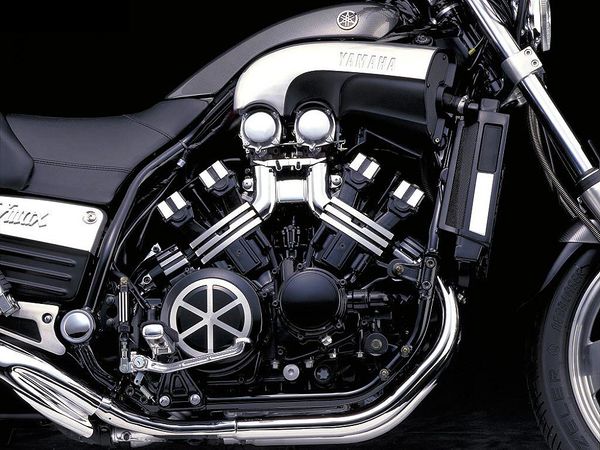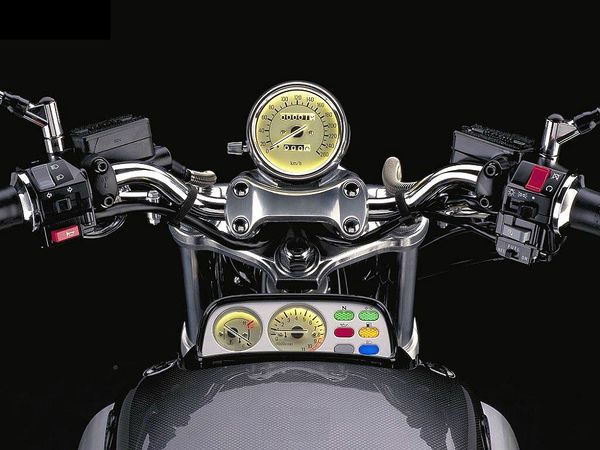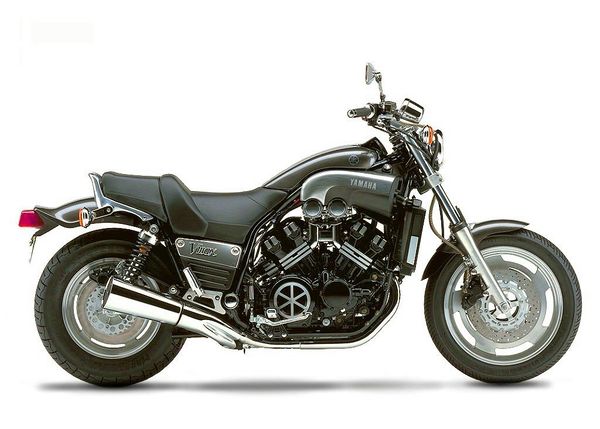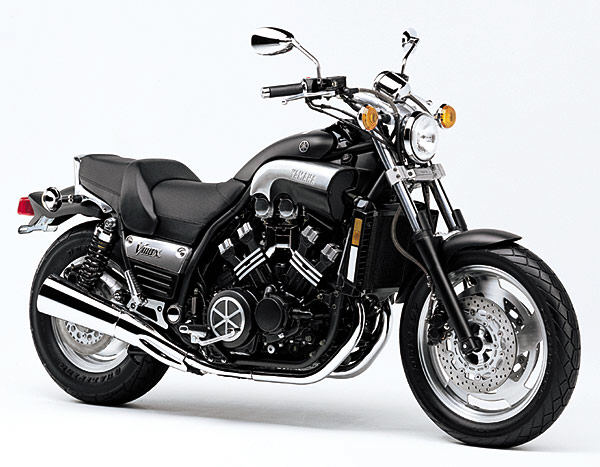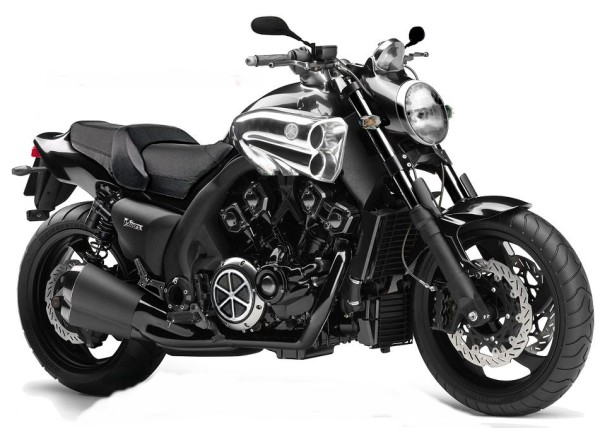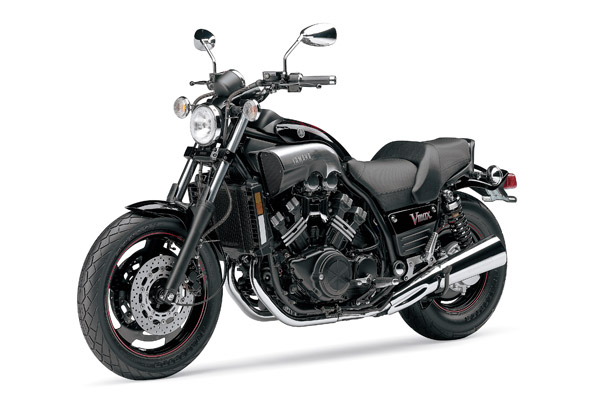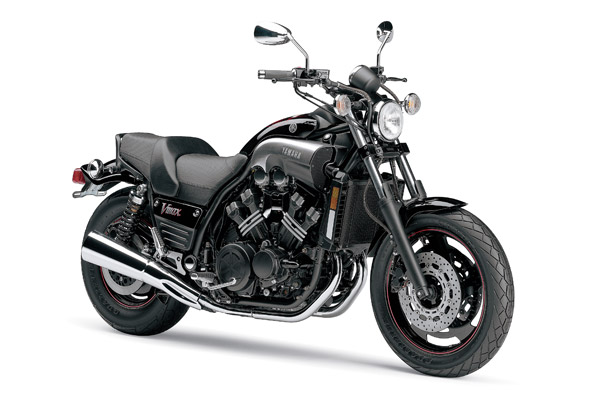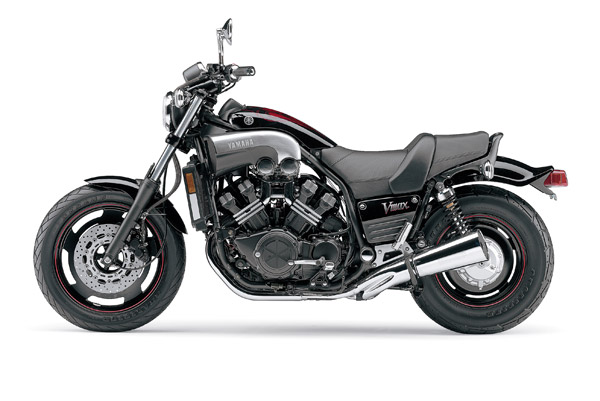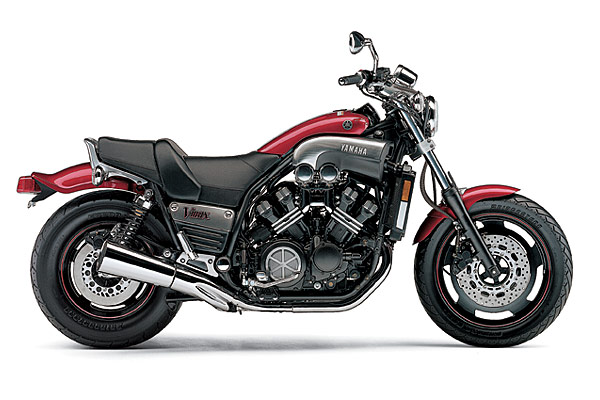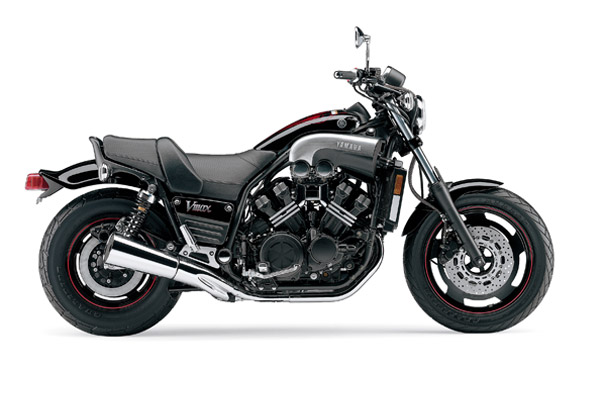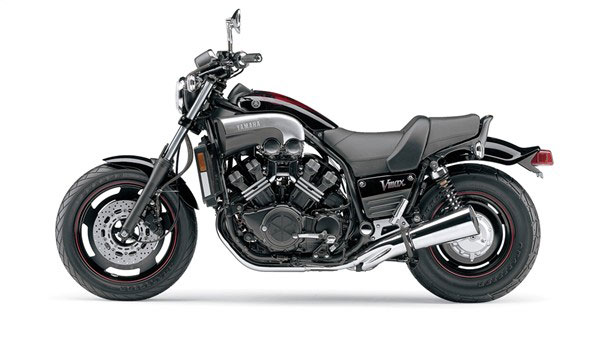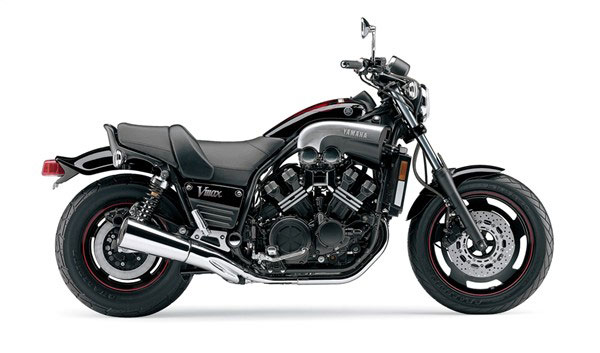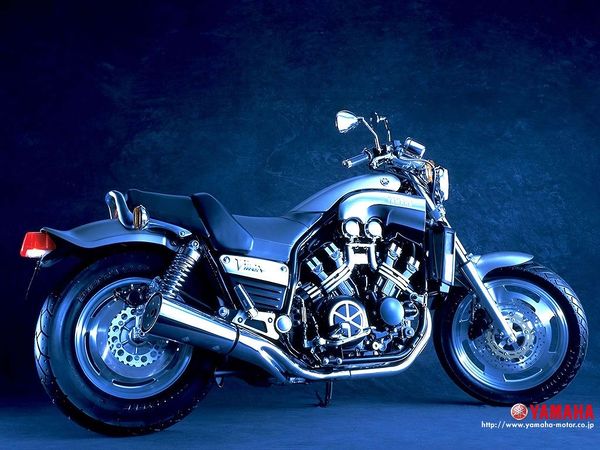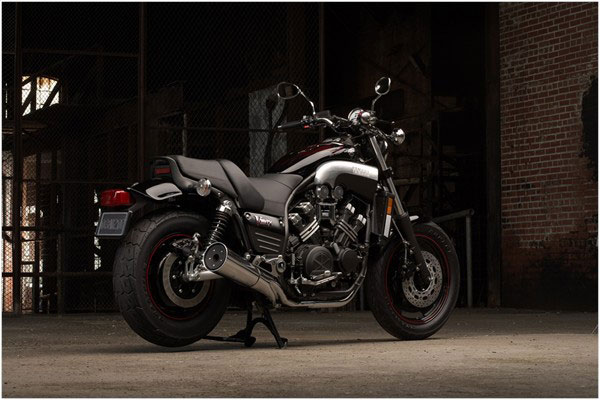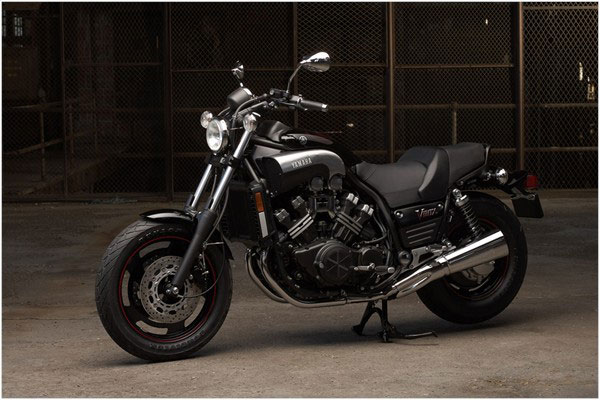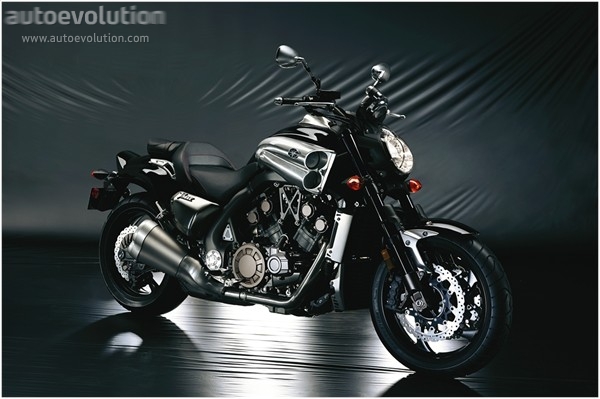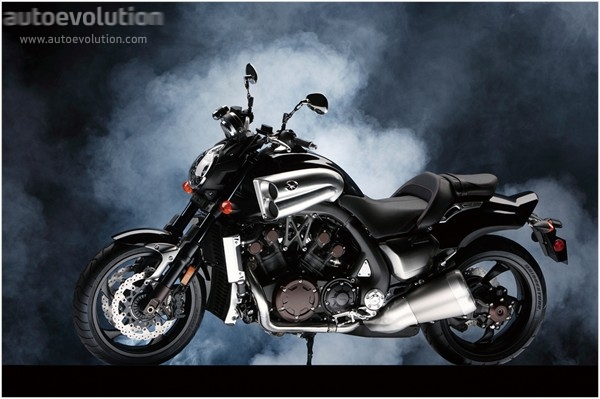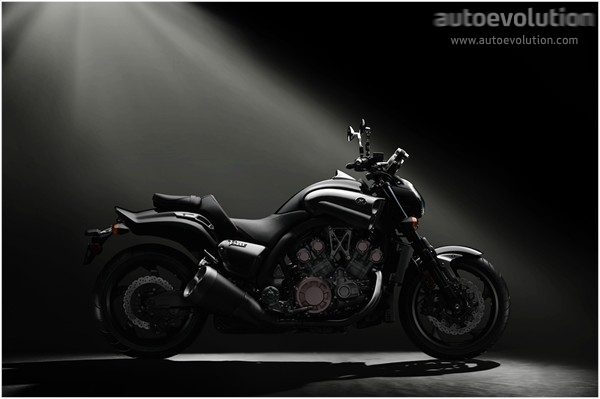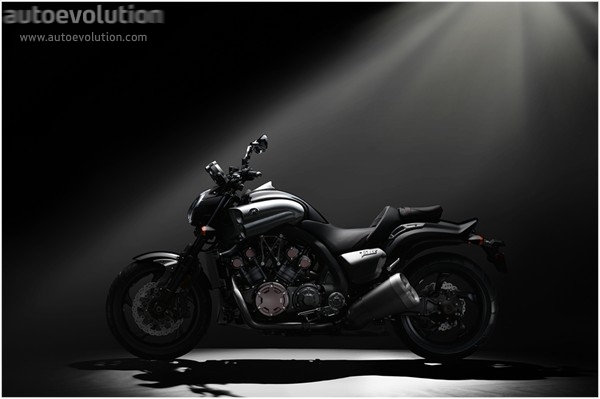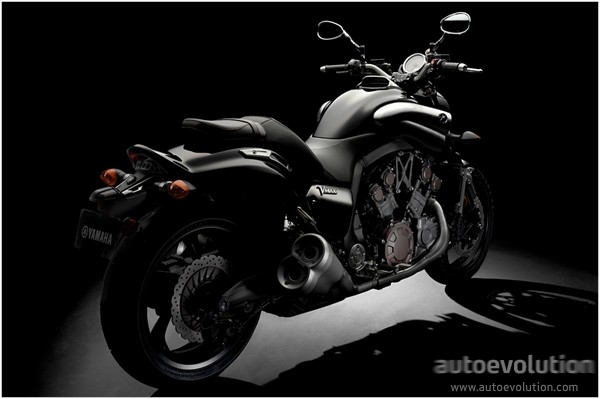Yamaha V-MAX
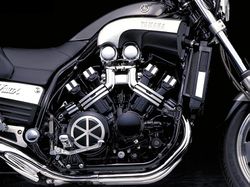 |
|
| Yamaha V-MAX | |
| Manufacturer | |
|---|---|
| Production | 1984 - 2010 |
| Class | Naked |
| Engine | Liquid Cooled, Four Stroke, V-four, DOHC, 4 Valves Per Cylinder |
| Bore / Stroke | 76.2mm x 76.2mm |
| Compression ratio | 10.5:1 |
| Horsepower | 144.96 HP (108.1 KW) @ 9000RPM |
| Torque | 87.04 ft/lbs (118.0 Nm) @ 7500RPM |
| Transmission | Gear box: Shaft Final Drive: Shaft |
| Suspension | Front: 52mm telescopic cartridge fork w/oxidized titanium coating. Fully adjustable preload, compression and rebound; 4.7 in travel Rear: Single shock w/remote reservoir and remote adjustable for preload, compression and rebound |
| Brakes | Front: 2x298mm Discs 2 Piston Calipers Rear: Single 282mm Disc 2 Piston Caliper |
| Front Tire | 110/90-18 |
| Rear Tire | 150/90-15 |
| Wheelbase | 62.6 inches (1590 mm) |
| Length | 90.59 inches (2301 mm) |
| Width | 31.3 inches (795 mm) |
| Seat Height | 30.12 inches (765 mm) |
| Weight | 264.0 kg (wet) |
| Recommended Oil | Yamalube 10w-40 |
| Fuel Capacity | 1.06 Gallon (4.00 Liters) |
| Manuals | Service Manual |
The Yamaha V-MAX was a Liquid Cooled, Four Stroke, V-four, DOHC, 4 Valves Per Cylinder Naked motorcycle produced by Yamaha between 1984 and 2010. Max torque was 87.04 ft/lbs (118.0 Nm) @ 7500 RPM. Claimed horsepower was 144.96 HP (108.1 KW) @ 9000 RPM.
Engine[edit | edit source]
A 76.2mm bore x 76.2mm stroke result in a displacement of just 1679.0 cubic centimeters.
Drive[edit | edit source]
The bike has a Shaft transmission. Power was moderated via the Multi-plate slipper clutch.
Chassis[edit | edit source]
It came with a 110/90-18 front tire and a 150/90-15 rear tire. Stopping was achieved via 2x298mm Discs 2 Piston Calipers in the front and a Single 282mm Disc 2 Piston Caliper in the rear. The front suspension was a 52mm telescopic cartridge fork w/oxidized titanium coating. Fully adjustable preload, compression and rebound; 4.7 in travel while the rear was equipped with a Single shock w/remote reservoir and remote adjustable for preload, compression and rebound. The V-MAX was fitted with a 1.06 Gallon (4.00 Liters) fuel tank. The wheelbase was 62.6 inches (1590 mm) long.
1984 - 2005 Yamaha V-MAX[edit | edit source]
This is a 1200cc motorcycle with a powerful V4 engine, shaft drive, and distinctive styling. Manufactured since 1984, the current V-Max is almost the same. In 2005, an all-new V-Max concept bike was presented. It had a new chassis and upgraded components all around.
2000 Yamaha V-MAX[edit | edit source]
One of the world's elite powercruisers, the 1999 V-Max is pure riding excitement and unforgiving power mashed together into a package which is fearsome, as it is rewarding. A machine for experienced riders, this 1190cc V4 beast produces 145 horsepower and exceptional torque right off idle, being equally fun when ridden aggressively uphill, or when blazing along the highway.
The V-Max are available in 100hp versions, too, with the Full-Power units sporting a V-Boost supercharger-type system which adds extra nerve when the rpm indicator flies past the 6000 mark.
2003 Yamaha V-MAX[edit | edit source]
V-Max is the sigil of raw power and road muscle excellence, and was one of the benchmarks powercruisers have been judged upon since its introduction. The 2002 V-MAX carries on the mighty 17-years-long heritage with yet another model year setting out to scorch the asphalt.
The 2002 V-MAX retains the successful 70-degree V4 architecture for its 1198cc liquid-cooled 16-valve engine mated to a 5-speed transmission with a hydraulic clutch and shaft final drive. Add in air-assisted forks, and rebound and spring preload adjustability for the dual rear shocks for an even more exhilarating riding experience.
2004 Yamaha V-MAX[edit | edit source]
It's hard to imagine how does an 1198cc V4 engine loaded into a roadster frame feels like, and there's only one way to find out: taking a ride aboard a machine like the 2003 Yamaha V-Max. THE muscle bike par excellence, the V-Max is capable to alter the rider's perception of reality, with mind-boggling torque and power on tap, breathtaking acceleration all across the rev range, superbike-grade brakes and sharp, street hooligan handling.
Add in the V-Boost induction which kicks off after 6000rpm for an even more savage behavior, and hod on well to the bars.
2005 Yamaha V-MAX[edit | edit source]
Built for speed and torque on tap, the 2004 V-Max arrives in a special, anniversary trim, with special red paint, blacked out rims with red striping, a serial-numbered plate, yellow turn signals with clear lenses and the same monstrous vibe about it.
The beastly V4 power plant retains the V-boost feature which adds even more craziness above 6000 rpm, while keeping vibration on the low side with the counterbalancer axle. Adjustable suspensions, a hydraulic clutch, R1-derived brakes and a low riding position make the V-Max an even more thrilling fun machine.
2007 Yamaha V-MAX[edit | edit source]
One of the elite muscle bikes in the industry, the 2006 V-Max is a good example of Yamaha's skills of blending unbridled power and mind-blowing acceleration with power cruiser styling and a legendary road stance. The V-Max has been a milestone in the segment for more than two decades so the 2006 model year only followed the same zero-compromise recipe.
The 1198cc V4 engine is fearsome, but going over 6000 revs gives you the real measure of what brutal really is. Thanks to the V-Boost technology, all hell breaks loose as the variable intake system opens up and simulates supercharger operation.
2010 Yamaha V-MAX[edit | edit source]
The Yamaha V-Max is a motorcycle manufactured by Yamaha, which is known for its powerful V4 engine, shaft drive, and distinctive styling. While famed for its quick acceleration, it is often criticized for its poor cornering ability and soft suspension. Instead of the V-Boost on the original carburated V-Max, the fuel injected VMAX uses YCC-I and YCC-T. Yamaha Chip Controlled Intake (YCC-I) is a new addition to the VMAX. The airhorns inside the airbox are lifted by a servo activated at 6650 RpM to open up the airway underneath. This shortens the length of the intake system from 150mm to 52mm. This system had it's first appearance in the Yamaha stable with the 2006 YZF-R1. The MV Agusta F4 Tamburini was the first bike with such a system. Massimo Tamburini invented this idea. It is called Torque Shift System (TSS) on the Agustas.
